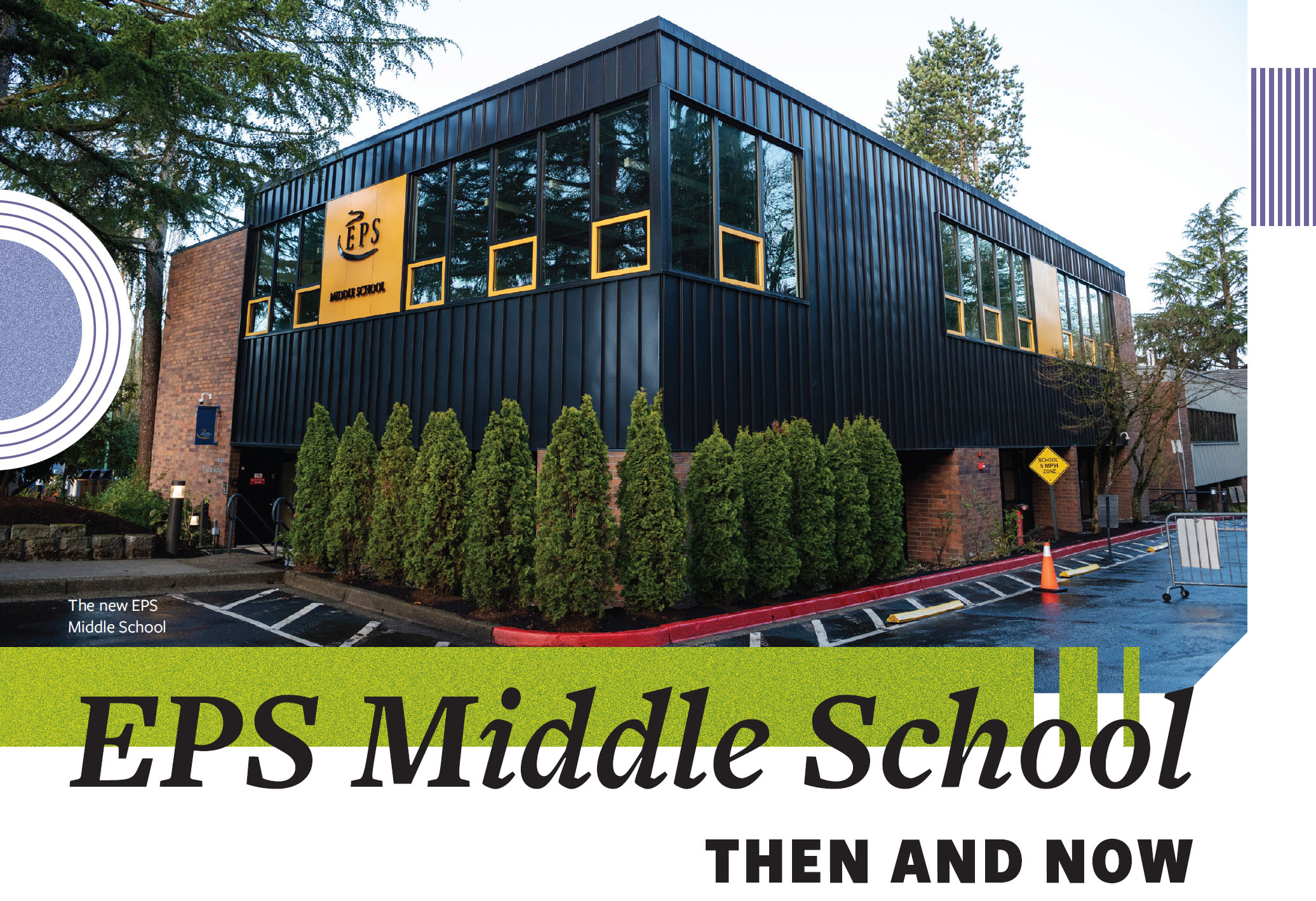
By Wendy Lawrence, former Head of Middle School and Sam Uzwack, Head of School-elect
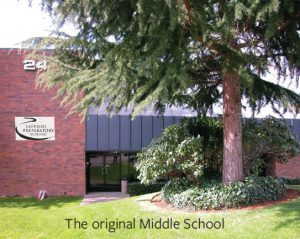 For this article, Eastside Prep’s first and second Middle School Heads, Wendy Lawrence (2005-2009) and Sam Uzwack (2009-2022), reflect on the changes and growth of the Middle School through the years.
For this article, Eastside Prep’s first and second Middle School Heads, Wendy Lawrence (2005-2009) and Sam Uzwack (2009-2022), reflect on the changes and growth of the Middle School through the years.
WENDY: My early memories of Eastside Prep Middle School are all questions—questions we asked each other, questions the students asked us, questions we wrote into the curriculum. Our early students were an awesome bunch—after all, they were willing to take a risk on this brand-new school with only sixteen kids, six bean bags, and a curriculum that was being developed as it was being taught. Those first students came for all sorts of reasons—some were bored at other schools, some were bullied, some were both, some were looking for challenge, some for acceptance. Some were brought by their parents, founding board members, who had visions of what authentic education could be. But really, what they all had in common was a desire to grow safely and creatively in their education—a desire to be trusted to learn in their own way, to honor their own goals, to ask their own questions.
SAM: What Wendy describes here captures exactly why I was so excited to join EPS. These founding principles still live on as they are “baked” into the culture. Oh, and I think one of the first things I did was toss all the bean bags.
WENDY: I think when people ask me about my time in the first few years of Eastside Prep, as a founding faculty member and Middle School Head shortly after that, they are expecting me to talk about what the faculty and staff did, how we built this school. And sure, there’s a lot to tell. I still remember the early all-day meetings where we brainstormed the grade-level questions (Who am I? Where did I come from?), and then later, smaller meetings where we integrated a math concept with a science idea or an English assignment with a history project. I remember a shared calendar, printed on paper, stretching the length of the upstairs hallway, that we used to plan integrated projects. I remember when we talked about what to call the classes and came up with Literary Thinking instead of English because we wanted to emphasize the tools, to acknowledge that learning is a process, not an end. To do what we wanted to do as a school, we wouldn’t be teaching kids history (is that even possible?), we would be teaching them how to think about history, how to question it, how to reflect on it—and to be fully purposeful in that, we needed new names for the classes. That may seem like a small detail, but I don’t think it is—I think committing so fully to our new ideas kept us honest. We built the foundation for the school on big ideas and open-ended questions, but we mortared it together with the smallest of details.
Those first students came for all sorts of reasons—some were bored at other schools, some were bullied, some were both, some were looking for challenge, some for acceptance.
– Wendy Lawrence
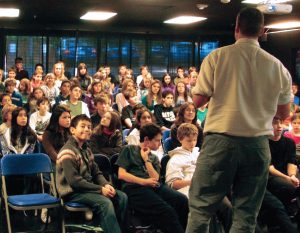 SAM: When I arrived, it was clear that the academic program reflected intense thought and creativity. Language matters, and the decision to use the term “thinking” in the course titles sets the frame for how we think about the disciplines…not just as buckets of facts, but lenses with which to interpret the world around us.
SAM: When I arrived, it was clear that the academic program reflected intense thought and creativity. Language matters, and the decision to use the term “thinking” in the course titles sets the frame for how we think about the disciplines…not just as buckets of facts, but lenses with which to interpret the world around us.
WENDY: I remember the growing pains of our young institution, tension between the board and the administration and the teachers. It’s a tension I’m proud to look back on since it only existed because we as an organization allowed it to exist, knowing that nothing new and brave comes in total comfort. I’ve since worked in places that wouldn’t allow that kind of tension—voices would be silenced before anything got awkward, and nothing would change. But at EPS, we lived in our uneasiness, the mess of creating something new. We argued at times but listened to each other. I remember Dr. Macaluso leading us through all of this, mentoring teachers and board members alike, suggesting reading and development, setting up conversations. I still think the way we allowed ourselves to live with uncertainty and the way Dr. Macaluso guided us through that uncertainty—with suggestion and patience, not direction or absolutes—set the stage for healthy innovation that continues to propel the school forward even today.
SAM: Dr. Macaluso enjoys ambiguity and uncertainty?
WENDY: But even though those are fun memories, the process of building the school had so little to do with us, the adults, and everything to do with the kids. Those EPS students in the first few years of our school founded our first after-school clubs and designed our first projects. And even though that’s a lot—shaping the programming from the ground up—they did something even bigger. Together, our founding students built a collaborative culture where “quirky” wasn’t just accepted, it was honored. Students who at previous schools had been “too smart” or “too different” found a place at EPS where their strengths were celebrated. Students who were used to being shut down when they asked too many questions now found themselves in the center of a new place where their questions were the very fuel that powered our growth.
The thing about honoring questions is that you must then also honor difference and inclusion, and that’s what I remember most about those first years. I remember thinking that anyone who walked in our doors was included, not passively, but audaciously, not welcomed so much as celebrated.
SAM: Summer 2009. The new guy has arrived on campus to find an office full of books, files, forms, and mementos left behind by the founding Middle School Head, Wendy Lawrence. The rest of the campus is empty. While the returning folks are on well-deserved breaks, the new guy is eager and nervous. You see, he has never done this job before, and there is a lot to learn. So much so that in the ensuing months, he would wear down the carpet between his office and that of Dr. Macaluso. Let’s just say he is not shy about asking questions…about anything. I remember a conversation with Wendy in which we were both a little bummed we would not be working together, as we had established a trusting relationship through the transition process.
That’s one of the things that makes EPS… we are willing to try new things and learn from our struggles.
-Sam Uzwack
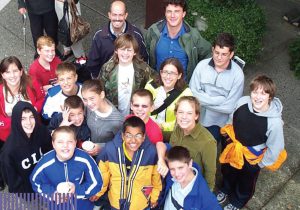 WENDY: I remember meeting Sam and being so excited to hand off the school to such an awesome guy. It was obvious that he, too, had that EPS curiosity—the humility to ask questions in order to learn and the drive to ask questions in order to challenge and change.
WENDY: I remember meeting Sam and being so excited to hand off the school to such an awesome guy. It was obvious that he, too, had that EPS curiosity—the humility to ask questions in order to learn and the drive to ask questions in order to challenge and change.
SAM: When I started at EPS, about ninety students called Building twenty-four their home, with about ten full-time faculty. We have since grown to 198 students, about twenty-five faculty, and a shiny new building we now call home. We have built new programs, created a robust and vibrant academic experience, and in recent years, focused energy on bringing our vision to life: guide students to create a better world.
One early initiative was bringing a one-to-one laptop program to the Middle School. Demand for tech resources was on the rise, and we were still operating computer labs that teachers needed to sign up for. But beyond the hardware constraints we faced, we pondered whether it was best to introduce laptops when students were younger and more likely to adopt our expectations, or in ninth grade when, well, they are ninth graders. We took it as a professional challenge to build a program that would teach students effective habits of mind, thus allowing them to leverage the awesome potential of their own machine.
Our faculty dove into preparing for the rollout, and we workshopped classroom management strategies and instructional methods. We targeted fall 2013 for rollout…and waited for the machines to arrive.
And waited. And waited. And waited.
Supply chain issues may be the hot topic now, but they are nothing new. And as our laptops languished in a container in Texas, we patiently awaited their arrival. In characteristic EPS fashion, our students and faculty adapted to the delayed rollout, until they finally arrived. This marked a key milestone in the development of our Middle School program, as we now had the platform to try whatever we might want to with technology. This would pave the way for three new courses: sixth-grade BOTZ, seventh-grade MAKE, and eighth-grade WEB. Jonathan Briggs, Director of Strategy, Technology, and Innovation, describes these classes as “on-ramps,” allowing all students to experience and explore the world of tech and innovation, thus preparing them for a deeper study in the future.
WENDY: I love this story because to me this is everything about EPS: innovate and try new things and then don’t blink when something goes wrong. In fact, sometimes when something goes wrong, EPS just gets better.
SAM: One of the mantras we want to inculcate in our students is that “failure is not the opposite of success.” While I am proud of the accomplishments of the past thirteen years, I am equally proud of the programs we tried and did not continue, strange as that may sound. That’s one of the things that makes EPS—we are willing to try new things and learn from our struggles. With the help of our former tech faculty member Gunnar Mein, we developed a program to address the challenge of providing students with more challenge. EP-Stretch featured a fifth/sixth series of challenges and a seventh/eighth mini-seminar. We learned, however, that Middle Schoolers are not quite there yet in wanting extra homework, no matter how interested they are in the subject matter. This insight shifted our approach to providing more challenge by building in opportunities directly within the classroom experience.
Of all that we’ve accomplished over my tenure, perhaps the one I am most proud of is our Advisory Program, as it reflects a true team effort, multiple iterations, and serves as the backbone of the overall Middle School experience. We now have more programming than we have time to implement, something I believe to be a rare problem in schools. Features of the program now include:
- Specific grade-level teams at fifth and sixth grades to support students and families joining the community
- Grade Level Coordinators who oversee programming and monitor the health of the grade
- Social Emotional Learning lessons provided by Counselors
- Executive functioning lessons provided by Learning Support
- DEI (Diversity, Equity, and Inclusion) lessons provided by our EICL (Equity, Inclusion, and Compassionate Leadership) Co-Coordinators
And yes, some good old-fashioned fun together along the way.
While I am proud of the accomplishments of the past thirteen years, I am equally proud of the programs we tried and did not continue, strange as that may sound.
-Sam Uzwack
As we shored up our Advisory Program, we surfaced a new challenge (isn’t that always the way?). While we were pleased with our process for teaching new students about the culture, we were missing the boat when it came to our families. Two members of our fifth-grade faculty, Karen Mills and Anthony Colello, proposed that we develop parent education experiences, and the New Parent Series was born. Over three evenings, fifth and sixth grade parents heard and experienced our approach to school: academics, technology, and social emotional learning. Not only did the evenings serve to share content, but to build the relationships necessary for the hard work ahead. By merging the very difficult work of both schooling and parenting, the student is placed squarely at the center of the experience, with the support of the adults girding their work. A couple of years later, we would add an evening for seventh and eighth grade parents, given the rapid pace of adolescent development over the Middle School
years.
WENDY: Learning about the New Parent Series is so cool. When we started, we actually had morning meetings once a week that originally were “required” for parents to attend. The goal, of course, was to include whole families, but making it a requirement was obviously too much of a burden for many people. That quickly went away, but the weekly meetings remained with many parents attending. I love that the school has consistently included the whole community, how it listens to feedback about what works and what doesn’t, and how, of course EPS is always ready to try something new.
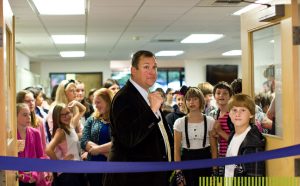 SAM: There is so much more I could write about: evolving courses in physical education and the fine and performing arts; skills sequences in Literary and Historical Thinking Courses; reimagined math placement interviews; a beautiful new building that supports the kind of teaching we aspire to. But that will have to be for another day. At the time of this writing, our new Middle School Head, Sarah Peeden, is just beginning her EPS adventure. The timing could not be better; the EPS Middle School features a dynamic faculty, robust program, and one of the kindest cultures you’ll find. Yet there is always work to be done. Sarah will bring a new perspective and fresh eyes, and we are lucky to have her join the team. I could list all the “opportunities” that are on the horizon, but I don’t want to spoil the story.
SAM: There is so much more I could write about: evolving courses in physical education and the fine and performing arts; skills sequences in Literary and Historical Thinking Courses; reimagined math placement interviews; a beautiful new building that supports the kind of teaching we aspire to. But that will have to be for another day. At the time of this writing, our new Middle School Head, Sarah Peeden, is just beginning her EPS adventure. The timing could not be better; the EPS Middle School features a dynamic faculty, robust program, and one of the kindest cultures you’ll find. Yet there is always work to be done. Sarah will bring a new perspective and fresh eyes, and we are lucky to have her join the team. I could list all the “opportunities” that are on the horizon, but I don’t want to spoil the story.
To me, one of the joys—and, quite frankly, challenges—of working at EPS is that we are never done. And we will never be done. The journey is the destination. Challenges emerge, they are solved, and new challenges take their place. We are on a mission to figure out how students best learn. As technology evolves, the world progresses, and kids’ lives change, we know that what worked a few years ago may not today. We know that there are new ways to support students’ well-being, new techniques of exploring our wonderfully complex world, that we have not even considered yet. And while I am content with the work we have accomplished together for our Middle School, I am even more excited to see where we go next.

